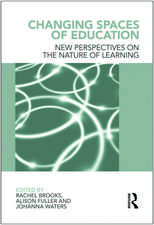The Aesthetic Dimensions of Educational Administration & Leadership
Editat de Eugenie A. Samier, Richard Batesen Limba Engleză Paperback – 22 mar 2012
This approach is covered here, taking into account the importance of aesthetics on all aspects of the administrative and leadership world: the ways ideas and ideals are created, how their expression is conveyed, the impact they have on interpersonal relationships and the organisational environment that carries and reinforces them and the moral boundaries or limits that can be established or exceeded.
While presenting a significant departure from conventional studies in the field, the international contributors reflect a continuity of thought on administrative and leadership authority, from the writings of Plato through to current theory.
| Toate formatele și edițiile | Preț | Express |
|---|---|---|
| Paperback (1) | 481.81 lei 43-57 zile | |
| Taylor & Francis – 22 mar 2012 | 481.81 lei 43-57 zile | |
| Hardback (1) | 1057.89 lei 43-57 zile | |
| Taylor & Francis – 4 mai 2006 | 1057.89 lei 43-57 zile |
Preț: 481.81 lei
Nou
Puncte Express: 723
Preț estimativ în valută:
92.19€ • 96.52$ • 76.28£
92.19€ • 96.52$ • 76.28£
Carte tipărită la comandă
Livrare economică 07-21 aprilie
Preluare comenzi: 021 569.72.76
Specificații
ISBN-13: 9780415511582
ISBN-10: 0415511585
Pagini: 240
Ilustrații: 2 tables
Dimensiuni: 156 x 234 x 13 mm
Greutate: 0.44 kg
Ediția:1
Editura: Taylor & Francis
Colecția Routledge
Locul publicării:Oxford, United Kingdom
ISBN-10: 0415511585
Pagini: 240
Ilustrații: 2 tables
Dimensiuni: 156 x 234 x 13 mm
Greutate: 0.44 kg
Ediția:1
Editura: Taylor & Francis
Colecția Routledge
Locul publicării:Oxford, United Kingdom
Public țintă
Postgraduate, Professional, and UndergraduateCuprins
Introduction: Foundations and History of the Social Aesthetic. Part One: Philosophical Foundations. Imagination, Taste, the Sublime, and Genius in Administration: A Kantian Critique of Organisational Aesthetics. The Art and Legacy of the Romantic Tradition: Implications for Power, Self--Determination and Education. Collingwood on Imagination, Expression and Action: Advancing an Aesthetically Critical Study of Educational Administration. The Metaphysical Sources of Pragmatic Aesthetic Leadership. On the Contribution of Critical Theory to Educational Administration and Leadership: Aesthetic Experience as Resistance to the ‘Iron Cage’ of Dominative Administrative Rationality. Part Two: Aesthetic Sources for Administration and Leadership. Aesthetic Leadership: Leaders as Architects. The Victorian Hangover: A Lively Discussion of Colourful Headmasters in the works of Mr. Dickens and Ms. Brontë. A Narrative Looking Glass for Leadership Studies in Organization: Cinema and Literature as Source and Reflective Medium. Living Aesthetically and the Poetics of Dailiness for Leadership. Part Three: Critical Applications to Administration and Leadership. The Aesthetics of Charisma: Architectural, Theatrical, and Literary Dimensions. Aesthetics and Art and their Place in the Theory and Practice of Leadership in Education. Aesthetics, Heroism and the Cult of 'the Leader'. Towards an Aesthetics for Educational Administration. Notes on Contributors. Name Index. Subject Index
Notă biografică
Eugenie A. Samier is a Senior Lecturer and coordinator of the EdD program at the British University in Dubai, and an Honorary Lecturer at the University of Birmingham. She is also editor of Ethical Foundations for Educational Administration and principal editor of Aesthetic Dimensions of Educational Administration and Leadership. Her research interests are in administrative and leadership philosophy and theory, particularly in ethics and aesthetic critiques.
Richard Bates is at the Deakin University, School of Social & Cultural Studies in Education in Australia.
Richard Bates is at the Deakin University, School of Social & Cultural Studies in Education in Australia.
Descriere
Using aesthetics as a theoretical framework for thinking about leadership issues, this book highlights the importance of aesthetics in today’s international, educational settings.






















